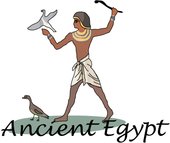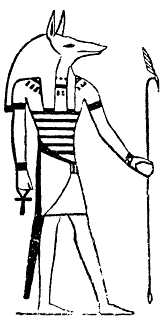Anubis
|
|
Anubis, is the Greek name for the ancient god in Egyptian mythology whose hieroglyphic is more accurately spelt Anpu (also Anup, Anupu, Wip, Ienpw, Inepu, Yinepu, or Inpw). Prayers to Anubis have been found carved on the most ancient tombs in Egypt, indeed the Unas text (line 70) associates him with the Eye of Horus.
Lord of the dead
Originally, in the Ogdoad system, he was god of the underworld, and his name is frequently thought to have reflected this, meaning something like putrefaction. He was said to have a wife, Anput, who was really just his female aspect, her name being his with an additional feminine suffix (the t), who was depicted exactly the same (though feminine). His father was originally said to be Ra, as he was the creator god, and thus his mother was said to be Hesat, Ra's wife, who later was identified as Hathor (who her identity was remarkably similar to). As lord of the underworld, Anubis was identified as the father of Kebechet, the goddess of the purification of bodily organs due to be placed in canopic jars, during mummification.
Dogs and jackals often loitered at the edges of the desert, especially near the cemeteries where the dead were buried, in fact, it is thought that the Egyptians began the practice of making elaborate graves and tombs to protect the dead from desecration by jackals. In consequence, Anubis was usually thought of as a jackal, an association re-inforced by certain variations of his hieroglyph, which can be translated as young dog. Thus, ancient Egyptian texts say that Anubis, like a jackal, silently walked through the shadows of life and death and lurked in dark places, watchful by day as well as by night.
In art, he was usually depicted as a man with the head of a jackal, and alert ears, often wearing a ribbon, and wielding a whip. On very rare occasions, Anubis was shown fully human, or slightly more frequently as fully jackal. However, Anubis was also depicted as black, rather than brown, the colour of jackals, since black was the colour that the body turned as a result of mummification.
As ruler over the dead, he was given titles such as He who is set upon his mountain, in reference to his sitting atop desert cliffs to guard multiple necropolis, and Chontamenti (also spelt Khentimentiu, and Khentamenti), meaning Lord of the Westerners, in reference to Egyptian belief that the entrance to the underworld was towards the west, since that was the direction in which the sun set. As ruler, he was also said to have been victorious over the dark forces (described as nine bows), which also, naturally, lurk in the underworld, gaining him the title Jackal ruler of the bows.
As king of the underworld, he was also considered to be the one who weighed the heart of the dead against the feather of Ma'at (the concept of truth), gaining him the title He who counts the hearts. One of the reasons that the ancient Egyptians took such care to preserve their dead with sweet-smelling herbs was that it became believed Anubis would check each person with his keen canine nose. Only if they smelled pure would he allow them to enter the Kingdom of the Dead.
Embalmer
Anubis_statuette_2.jpg
Following the merging of the Ennead and Ogdoad belief systems, as a result of the identification of Atum with Ra, and their compatability, Anubis became considered a lesser god in the underworld, giving way to the more popular Osiris. Indeed, when the Legend of Osiris and Isis emerged, it was said that when Osiris had died, Anubis stood down from his position out of respect for Osiris.
Since he had been more associated with beliefs about the weighing of the heart, than had Osiris, Anubis retained this aspect, and became considered more the gatekeeper of the underworld, the Guardian of the veil (of death). As such he was said to protected souls as they journeyed there, and thus be the patron of lost souls (and consequently orphans). Rather than god of death, he had become god of dying, and consequently funeral arrangements. It was as the god of dying that his identity merged with that of Wepwawet, a similar jackal-headed god, associated with funerary practice, who had been worshipped in Upper Egypt, wheras Anubis' cult had centred in Lower Egypt.
As one of the most important funerary rites in Egypt involved the process of embalming, so it was that Anubis became the god of embalming, in the process gaining titles such as He who belongs to the mummy wrappings, and He who is before the divine [embalming] booth. High priests often wore the Anubis mask to perform the ceremonial deeds of embalming. It also became said, frequently in the Book of the dead, that it had been Anubis who embalmed the dead body of Osiris, with the assistance of the other main funerary deities involved - Nepthys, and Isis. Having become god of embalming, Anubis became strongly associated with the (currently) mysterious and ancient imiut fetish, present during funerary rites, and Bast, who by this time was goddess of ointment, initially became thought of as his mother.
However, as lesser of the two gods of the underworld, he gradually became considered the son of Osiris, but Osiris' wife, Isis, was not considered his mother, since she too inappropriately was associated with life. Instead, his mother became considered to be Nepthys, who had become strongly associated with funerary practice, indeed had in some ways become the personification of mourning, and was said to supply bandages to the deceased. Subsequently, this apparant infidelity of Osiris was explained in myth, in which it was said that a sexually frustrated Nepthys had disguised herself as Isis, to appeal to her husband, Set, but he did not notice her as he was gay, and infertile, wheras Osiris, Isis' husband, did, mistaking her for his wife, resulting in Anubis' birth. Some, more homophobic, versions of the myth depict Set as the father.
In later times, during the ptolomeic period, as their functions were similar, Anubis was identified as the Greek god Hermes, becoming Hermanubis. The centre of this cult was in uten-ha/Sa-ka/Cynopolis. In Book xi of The Golden Ass by Apuleius, we find evidence that the worship of this god was maintained in Rome at least up to the 2nd century. Indeed, Hermanubis also appears in alchemical and hermetical literature of the Middle Ages and the Renaissance.
Ancient Egypt Clipart and Pictures
- Ancient Egypt Architecture (http://classroomclipart.com/cgi-bin/kids/imageFolio.cgi?direct=History/Ancient_Civilizations/Ancient_Egypt/Architecture)
- Ancient Egypt Art (http://classroomclipart.com/cgi-bin/kids/imageFolio.cgi?direct=History/Ancient_Civilizations/Ancient_Egypt/Art)
- Ancient Egypt Clipart (http://classroomclipart.com/cgi-bin/kids/imageFolio.cgi?direct=History/Ancient_Civilizations/Ancient_Egypt/Clipart)
- Ancient Egypt Clothing (http://classroomclipart.com/cgi-bin/kids/imageFolio.cgi?direct=History/Ancient_Civilizations/Ancient_Egypt/Clothing)
- Ancient Egypt Architecture (http://classroomclipart.com/cgi-bin/kids/imageFolio.cgi?direct=History/Ancient_Civilizations/Ancient_Egypt/Commerce)
- Ancient Egypt Daily Life (http://classroomclipart.com/cgi-bin/kids/imageFolio.cgi?direct=History/Ancient_Civilizations/Ancient_Egypt/Daily_Life)
- Ancient Egypt Games and Toys (http://classroomclipart.com/cgi-bin/kids/imageFolio.cgi?direct=History/Ancient_Civilizations/Ancient_Egypt/Games_and_Toys)
- Ancient Egypt Hieroglyphs (http://classroomclipart.com/cgi-bin/kids/imageFolio.cgi?direct=History/Ancient_Civilizations/Ancient_Egypt/Hieroglyphs)
- Ancient Egypt People (http://classroomclipart.com/cgi-bin/kids/imageFolio.cgi?direct=History/Ancient_Civilizations/Ancient_Egypt/Historical_People)
- Ancient Egypt Illustrations (http://classroomclipart.com/cgi-bin/kids/imageFolio.cgi?direct=History/Ancient_Civilizations/Ancient_Egypt/Illustrations)
- Ancient Egypt Mummies (http://classroomclipart.com/cgi-bin/kids/imageFolio.cgi?direct=History/Ancient_Civilizations/Ancient_Egypt/Mummies)
- Ancient Egypt Musical Instruments (http://classroomclipart.com/cgi-bin/kids/imageFolio.cgi?direct=History/Ancient_Civilizations/Ancient_Egypt/Musical_Instruments)
- Ancient Egypt Pyramids (http://classroomclipart.com/cgi-bin/kids/imageFolio.cgi?direct=History/Ancient_Civilizations/Ancient_Egypt/Pyramids)
- Ancient Egypt Religion (http://classroomclipart.com/cgi-bin/kids/imageFolio.cgi?direct=History/Ancient_Civilizations/Ancient_Egypt/Religion)
- Ancient Egypt Statues (http://classroomclipart.com/cgi-bin/kids/imageFolio.cgi?direct=History/Ancient_Civilizations/Ancient_Egypt/Statues)
- Ancient Egypt Temples (http://classroomclipart.com/cgi-bin/kids/imageFolio.cgi?direct=History/Ancient_Civilizations/Ancient_Egypt/Temples)
- Ancient Egypt Transportation (http://classroomclipart.com/cgi-bin/kids/imageFolio.cgi?direct=History/Ancient_Civilizations/Ancient_Egypt/Transportation)
- Ancient War and Armies (http://classroomclipart.com/cgi-bin/kids/imageFolio.cgi?direct=History/Ancient_Civilizations/Ancient_Egypt/War_and_Armies)


